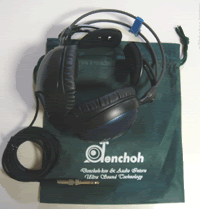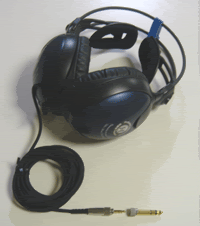Superpredator
Headphoneus Supremus
- Joined
- Nov 5, 2005
- Posts
- 2,436
- Likes
- 18
Looks like an AT, but I don't see AT mentioned anywhere in the translated description. I've seen some bizarre collaborations between AT & others. AT & Intel? Something else? Google was not my friend in this case.
【新品・逸品】USTヘッドフォン EXE-313★送料込・代引料込★



Apologies for the mixed katakana (I guess that's what it is) and English. I don't feel like separating them.
【一般音楽用】
[For general music]
●伝聴研(※1)とオーディオインテル社とのコラボレーション!!
- Collaboration of 伝聴研 (*1) and audio Intel Corp.!!
伝聴研が5年の歳月を経て、思いを寄せたヘッドホンを復活させ、
伝聴研 revives the headphone which felt affection through the time for five years,
このヘッドホンにUST(Ultra Sound Technology)技術(※2)を組み込み、
UST (Ultra Sound Technology) technology (*2) is built into these headphone,
世界でも最高峰と自信を持っておすすめできるヘッドホンが完成しました。
The headphone which we can recommend also in the world to you with the highest peak and confidence were completed.
臨場感、音場感、繊細に加え高解像度な製品仕上げ、音楽ファン、
presence and a feeling of a sound place -- delicate -- adding -- high resolution product finish and a music fan,
ヘッドホンファンの皆様へ是非お奨めする逸品です。
It is the excellent piece which we surely recommend to you to you, headphone fans.
※1伝聴研とは、聴覚訓練システムの研究・開発を行う研究所で、所長である傳田先生は、
* Mr. Denda who 1 伝聴研 is the research institute which performs research and development of a hearing training system, and is the head,
1973年~1997年、洗足学園大学クラリネット講師。
1973- 1997, the Senzoku Gakuen College clarinet lecturer.
著書に「日本人はクラシック音楽をどう把握するか?」
How does "Japanese grasp classical music on a work?"
「クラリネットサキソフォンの為のシングルリード調整法」(ともに芸術現代社)。
"The single lead adjusting method for a clarinet saxophone" (both art present age company).
現在では“流音聴力”理論、母国言語聴覚認知論に基づく聴覚矯正及び学習システム、
The hearing reform based on "style sound hearing ability" theory and a mother country language hearing cognitive theory at the present, and a learning system,
強制的音楽療法として音楽が心身に及ぼす影響などの研究をすすめています。
Research of the influence music affects mind and body as compulsory musical therapy is recommended.
※2UST技術とは、伝聴研とオーディオインテル社の共同開発に生まれた特殊技術。(世界特許)
* Special technology born to joint development of 伝聴研 and audio Intel Corp. with 2UST technology. (World patent)
●音楽での倍音の粒や、波が砂を洗う音、小川のせせらぎなど、今までどんなヘッドホンでも
- It is with any headphone until now [, such as a grain of the double sound in music, and a little stream of the sound from which a wave washes sand, and a brook, ].
再現できなかった微細・繊細な音が、まるで顕微鏡で見た世界のように忠実に再現され、
A detailed and delicate sound which was not able to be reproduced is faithfully reproduced just like the world seen under the microscope,
新しい音の世界に引き込まれることでしょう。
It will be drawn in the world of a new sound.
●生演奏の感動を求めて!
- Ask for impression of live music!
超高音域再生に伴う臨場感、音場感、リズム等の音楽情報の再現は、
Reappearance of music information, such as presence accompanying super-loud-sound region reproduction, a feeling of a sound place, and a rhythm,
既存のスピーカーシステムでは難しい。現実に演奏会場でのあの雰囲気を
In the existing speaker system, it is difficult. It is that atmosphere in the performance hall actually.
オーディオ装置では感じとることができていない。
It cannot understand with audio equipment.
つまり、演奏会場で聴いた音楽と音響再生とには異差が生じているということになる。
That is, the music and sound reproduction which were heard at the performance hall will be told that the different difference has arisen.
UST技術は、この課題を前提に開発しました。
UST technology was developed on the assumption that this subject.
特に重視したことは音楽でいう「ノリ」つまりリズムです。これが演奏家を
Especially the thing thought as important is, "the laver, i.e., the rhythm," as used in the field of music. This is a player.
理解する重要なポイントとなります。
It becomes the important point to understand.
そのリズムを明解にするため、可聴周波数帯域~超音波帯域の周波数のコントロールと
In order to make the rhythm lucid, it is control of the frequency of an audio frequency zone - ultrasonic wave zone.
音の立上り(インパルス応答)を追求した結果、臨場感、音場感が明解になりました。
As a result of pursuing the standup (impulse response) of sound, presence and a feeling of a sound place became lucid.
またUST効果は、一般の可聴帯域再生と異なり可聴周波数帯域~超音波帯域の
Moreover, the UST effect differs from general 可聴 zone reproduction, and is an audio frequency zone - ultrasonic wave zone.
音声出力波形補正をし、正常な形に復元します。
Voice response waveform compensation is carried out and it restores to a normal form.
つまり、従来のオーディオシステムには不可欠なテクノロジーと言えます。
That is, it can be said to be technology indispensable to the conventional audio system.
オーディオファイルの方々と音楽家の中間の橋渡しを念頭に置き、食い違いを調べて分かった
The inconsistency was investigated and understood bearing in mind people of an audio file, and middle mediation of a musician.
リズム感という問題は音響再生に於いて一番重要な要素であることが明解になって参りました。
It is becoming lucid that the problem of rhythmic sense is the most important element in sound reproduction.
【補 正】
[A 補 positive]
可聴周波数帯域から超音波帯域までの広帯域を補正します。
The broadband from an audio frequency zone to an ultrasonic zone is rectified.
【効果と作用】
[An effect and an action]
◎上記補正により、臨場感と音場の忠実な再現から、脳内活性におけるリラクゼーション効果。
O The relaxation effect [ in / by the above-mentioned compensation / the activity within a brain from faithful reappearance of presence and a sound place ].
◎粗悪な録音ソフトが聴き安くなり音楽が楽しめる。
O Crude recording software hears it, it becomes cheap, and music can be enjoyed.
◎忠実な再現により演奏意図がくみ取れ演奏者を再評価する。
O A performance intention can be drawn up by faithful reappearance and reappraise a player.
◎高域のみならず低域の分解能も明確に向上。
O Not only a quantity region but low-pass resolution improves clearly.
◎全ての音楽が楽しくなる。
O All music becomes pleasant.
●定格(テクニカルデータ)
- Rating (technical data)
形式:密閉ダイナミック型
Form: Sealing dynamic type
感度:102dB ±3.0dB/1mW at500Hz
Sensitivity: 102dB±3.0dB/1mW at500Hz
周波数特性:5~40,000Hz
Frequency characteristic: 5-40,000Hz
最大入力:1600mW (JEITAに準拠)
The maximum input: 1600mW (based on JEITA)
インピーダンス:60Ω ±20%
Impedance: 60 ohms ±20%
質量:300g (コード除く)
Mass: 300g (code 除く)
プラグ:標準/ミニ 金メッキステレオ 2ウェイ
Plug: A standard/mini Gilding stereo Two ways
コード(シース/素材/長さ):布巻き/Hi-OFC/3.0m (片出し)
code (sheath / material / length): -- cloth volume / Hi-OFC/3.0m (a piece -- taking out)
【新品・逸品】USTヘッドフォン EXE-313★送料込・代引料込★



Apologies for the mixed katakana (I guess that's what it is) and English. I don't feel like separating them.
【一般音楽用】
[For general music]
●伝聴研(※1)とオーディオインテル社とのコラボレーション!!
- Collaboration of 伝聴研 (*1) and audio Intel Corp.!!
伝聴研が5年の歳月を経て、思いを寄せたヘッドホンを復活させ、
伝聴研 revives the headphone which felt affection through the time for five years,
このヘッドホンにUST(Ultra Sound Technology)技術(※2)を組み込み、
UST (Ultra Sound Technology) technology (*2) is built into these headphone,
世界でも最高峰と自信を持っておすすめできるヘッドホンが完成しました。
The headphone which we can recommend also in the world to you with the highest peak and confidence were completed.
臨場感、音場感、繊細に加え高解像度な製品仕上げ、音楽ファン、
presence and a feeling of a sound place -- delicate -- adding -- high resolution product finish and a music fan,
ヘッドホンファンの皆様へ是非お奨めする逸品です。
It is the excellent piece which we surely recommend to you to you, headphone fans.
※1伝聴研とは、聴覚訓練システムの研究・開発を行う研究所で、所長である傳田先生は、
* Mr. Denda who 1 伝聴研 is the research institute which performs research and development of a hearing training system, and is the head,
1973年~1997年、洗足学園大学クラリネット講師。
1973- 1997, the Senzoku Gakuen College clarinet lecturer.
著書に「日本人はクラシック音楽をどう把握するか?」
How does "Japanese grasp classical music on a work?"
「クラリネットサキソフォンの為のシングルリード調整法」(ともに芸術現代社)。
"The single lead adjusting method for a clarinet saxophone" (both art present age company).
現在では“流音聴力”理論、母国言語聴覚認知論に基づく聴覚矯正及び学習システム、
The hearing reform based on "style sound hearing ability" theory and a mother country language hearing cognitive theory at the present, and a learning system,
強制的音楽療法として音楽が心身に及ぼす影響などの研究をすすめています。
Research of the influence music affects mind and body as compulsory musical therapy is recommended.
※2UST技術とは、伝聴研とオーディオインテル社の共同開発に生まれた特殊技術。(世界特許)
* Special technology born to joint development of 伝聴研 and audio Intel Corp. with 2UST technology. (World patent)
●音楽での倍音の粒や、波が砂を洗う音、小川のせせらぎなど、今までどんなヘッドホンでも
- It is with any headphone until now [, such as a grain of the double sound in music, and a little stream of the sound from which a wave washes sand, and a brook, ].
再現できなかった微細・繊細な音が、まるで顕微鏡で見た世界のように忠実に再現され、
A detailed and delicate sound which was not able to be reproduced is faithfully reproduced just like the world seen under the microscope,
新しい音の世界に引き込まれることでしょう。
It will be drawn in the world of a new sound.
●生演奏の感動を求めて!
- Ask for impression of live music!
超高音域再生に伴う臨場感、音場感、リズム等の音楽情報の再現は、
Reappearance of music information, such as presence accompanying super-loud-sound region reproduction, a feeling of a sound place, and a rhythm,
既存のスピーカーシステムでは難しい。現実に演奏会場でのあの雰囲気を
In the existing speaker system, it is difficult. It is that atmosphere in the performance hall actually.
オーディオ装置では感じとることができていない。
It cannot understand with audio equipment.
つまり、演奏会場で聴いた音楽と音響再生とには異差が生じているということになる。
That is, the music and sound reproduction which were heard at the performance hall will be told that the different difference has arisen.
UST技術は、この課題を前提に開発しました。
UST technology was developed on the assumption that this subject.
特に重視したことは音楽でいう「ノリ」つまりリズムです。これが演奏家を
Especially the thing thought as important is, "the laver, i.e., the rhythm," as used in the field of music. This is a player.
理解する重要なポイントとなります。
It becomes the important point to understand.
そのリズムを明解にするため、可聴周波数帯域~超音波帯域の周波数のコントロールと
In order to make the rhythm lucid, it is control of the frequency of an audio frequency zone - ultrasonic wave zone.
音の立上り(インパルス応答)を追求した結果、臨場感、音場感が明解になりました。
As a result of pursuing the standup (impulse response) of sound, presence and a feeling of a sound place became lucid.
またUST効果は、一般の可聴帯域再生と異なり可聴周波数帯域~超音波帯域の
Moreover, the UST effect differs from general 可聴 zone reproduction, and is an audio frequency zone - ultrasonic wave zone.
音声出力波形補正をし、正常な形に復元します。
Voice response waveform compensation is carried out and it restores to a normal form.
つまり、従来のオーディオシステムには不可欠なテクノロジーと言えます。
That is, it can be said to be technology indispensable to the conventional audio system.
オーディオファイルの方々と音楽家の中間の橋渡しを念頭に置き、食い違いを調べて分かった
The inconsistency was investigated and understood bearing in mind people of an audio file, and middle mediation of a musician.
リズム感という問題は音響再生に於いて一番重要な要素であることが明解になって参りました。
It is becoming lucid that the problem of rhythmic sense is the most important element in sound reproduction.
【補 正】
[A 補 positive]
可聴周波数帯域から超音波帯域までの広帯域を補正します。
The broadband from an audio frequency zone to an ultrasonic zone is rectified.
【効果と作用】
[An effect and an action]
◎上記補正により、臨場感と音場の忠実な再現から、脳内活性におけるリラクゼーション効果。
O The relaxation effect [ in / by the above-mentioned compensation / the activity within a brain from faithful reappearance of presence and a sound place ].
◎粗悪な録音ソフトが聴き安くなり音楽が楽しめる。
O Crude recording software hears it, it becomes cheap, and music can be enjoyed.
◎忠実な再現により演奏意図がくみ取れ演奏者を再評価する。
O A performance intention can be drawn up by faithful reappearance and reappraise a player.
◎高域のみならず低域の分解能も明確に向上。
O Not only a quantity region but low-pass resolution improves clearly.
◎全ての音楽が楽しくなる。
O All music becomes pleasant.
●定格(テクニカルデータ)
- Rating (technical data)
形式:密閉ダイナミック型
Form: Sealing dynamic type
感度:102dB ±3.0dB/1mW at500Hz
Sensitivity: 102dB±3.0dB/1mW at500Hz
周波数特性:5~40,000Hz
Frequency characteristic: 5-40,000Hz
最大入力:1600mW (JEITAに準拠)
The maximum input: 1600mW (based on JEITA)
インピーダンス:60Ω ±20%
Impedance: 60 ohms ±20%
質量:300g (コード除く)
Mass: 300g (code 除く)
プラグ:標準/ミニ 金メッキステレオ 2ウェイ
Plug: A standard/mini Gilding stereo Two ways
コード(シース/素材/長さ):布巻き/Hi-OFC/3.0m (片出し)
code (sheath / material / length): -- cloth volume / Hi-OFC/3.0m (a piece -- taking out)

